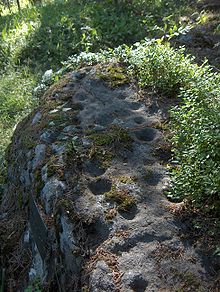Cup and ring mark






Cup and ring marks or cup marks are a form of prehistoric art found mainly in Atlantic Europe (Northern England, Scotland [1], Ireland, Brittany , Portugal and Galicia (North West Spain) [2]) and Mediterranean Europe (North West Italy, Thessalia Central Greece, Switzerland) although similar forms are also found throughout the world including Mexico, Brazil, Greece, and India [3], where the oldest cup marks so far recorded are to be found in the Paeleolithic cave shelter site of Chattan.
They consist of a concave depression, no more than a few centimetres across, pecked into a rock surface and often surrounded by concentric circles also etched into the stone. Sometimes a linear channel called a gutter leads out from the middle.
The decoration occurs as a petroglyph on natural boulders and outcrops and also as an element of megalithic art on purposely worked megaliths such as the slab cists of the Food Vessel culture, some stone circles and passage graves such as the clava tombs and on the capstones at Newgrange.
Italy
Numerous cup marks have been discovered in Val Camonica (Italy) associated to rock drawings.
Many engraved blocks are visible in the north west region of Italy (Piedmont): The best known places are "Val Susa", "La Bessa" [4] and "Valchiusella" [5].
Galicia (Spain)
Similar patterns are known in Galicia[6], which has given them the name of 'Galician style'. These types, the cup-and-ring, cup-and-ring with gutter and the gapped concentric circles motifs are shared between this part of Iberia and the British Isles, suggesting a cultural link along the coasts of Atlantic Europe[7], together with other cultural manifestations like megaliths or Bronze Age culture.
United Kingdom
Precisely dating megalithic art is difficult as even if the megalithic monument can be dated, the art may be a later addition. The Hunterheugh Crags cup and ring marks near Alnwick in Northumberland have recently been demonstrated to date back into the Early Neolithic through their stratigraphic relationship with other, datable features. Some cup marks have been found in Iron age contexts but these may represent re-used stones.
Where they are etched onto natural, flat stone it has been observed that they seem to incorporate the natural surface of the rock. Those at Hunterheugh are mostly connected to one another by gutters that can channel rainwater from one to the next, down the sloping top of the stone.
It has been suggested by archaeologist Clive Waddington that the initial Early Neolithic impetus to create the marks was forgotten and that the practice fell into abeyance until a second phase of creation continued the basic tradition but with less precision and more variability in design. The markers of this second phase moved the art from natural stones to megaliths as its symbolism was reinterpreted by Later Neolithic and Early Bronze Age people.
Their purpose is unknown although some may be connected with natural stone outcrops exploited by Neolithic peoples to make polished stone axes. A religious purpose has been suggested.
Other examples of sites with cup and ring marks include :
- Chatton Sandyford cairn and Fowberry petrogyphs in Northumberland
- Backstone Beck petroglyphs on Ilkley Moor
- Gardom's Edge in Derbyshire
- Bachwen portal dolmen in North Wales
- Dalladies long barrow, Kincardineshire
- Street House cairn in Cleveland
- Dalgarven Mill, North Ayrshire
- Mauchline Gorge, East Ayrshire
- Brodick, Isle of Arran
- Blackshaw Hill, North Ayrshire
- Kilmartin, Argyll
- Achnabreck, Argyll (Proc Soc Antiq Scot 1970-71)
- Balblair, Beauly, nr. Inverness
Ireland
Work at Drumirril in County Monaghan has uncovered Neolithic and early Bronze Age occupation evidence around the rock carvings there and this dating is generally accepted for most of the art.
Greece
See also
- Rock Drawings in Valcamonica
- European Megalithic Culture
- Petroglyph
- Petrosomatoglyph
- Dalgarven Mill
- Bullaun
References
- ^ http://www.cupstones.f9.co.uk/whatrcr.htm
- ^ http://www.whithorn.com/history-local-sites.asp?localsiteID=6
- ^ Francis Scott Elliot, George (1915). Prehistoric Man and his story. Seeley, Service. p. 398.
- ^ Rock art and cup marks of Bessa
- ^ Arte Rupestre della Valchiusella - Chiusella Valley Rock Art
- ^ R. Bradley et al., Rock art and the prehistoric Landscape of Galicia...
- ^ M. Stewart, Strath Tay in the Second Millennium BC. A Field Survey.
Further reading
- Beckensall, Stan and Laurie, Tim. 1998. Prehistoric Rock Art of County Durham, Swaledale and Wensleydale. County Durham Books. ISBN 1-897585-45-4
- Beckensall, Stan. 2001. Prehistoric Rock Art in Northumberland. Tempus Publishing. ISBN 0-7524-1945-5
- Beckensall, Stan. 2002. Prehistoric Rock Art in Cumbria. Tempus Publishing. ISBN 0-7524-2526-9
- Butter, Rachel. 1999. Kilmartin. Kilmartin House Trust. ISBN 0-9533674-0-1
- Hadingham, Evan. 1974. Ancient Carvings in Britain; A Mystery. Garnstone Press. ISBN 0-85511-391-X
- Morris, Ronald W.B. 1977. The Prehistoric Rock Art of Argyll. Dolphin Press. ISBN 0-85642-043-3
- Proc. Soc. Antiq. Scot. 1970-71. Vol.103. Pps.33-56.
- Papanikolaou Stelios. 600 Written Rocks. Channels of primeval knowledge Larissa <<ella>> Second Revised Edition 2005 spapinvest@yahoo.gr ISBN 960-8439-21-3
External links
- British Rock Art Collection
- Era – England's Rock Art (Currently only covers Northumberland and County Durham)
- Rockart – Web Access to Rock Art: the Beckensall Archive of Northumberland Rock Art – University of Newcastle Upon Tyne
- El Laberinto Atlántico - Galician Rock Art
